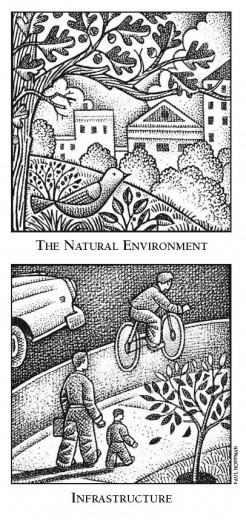Read an excerpt from this article below. You can download the full article by using the link at the end of the excerpt.
An important responsibility of planning commissioners and staff is to enhance their community’s character by strengthening its positive attributes and modifying negative ones. These efforts can increase the sense of pride and belonging people have, while making your community a more desirable place to live and work — boosting economic development efforts.
Many people bemoan the increasing homogeneity of communities. If, however, you look beyond the commercial strips and interstate interchanges, you will find that each community has its own identifiable character. It is the result of the needs, wants, and abilities of the people who live there and the physical attributes of the place.
The groundwork for strengthening the character of your community lies in a solid understanding of what you currently have. Your community’s natural and built environment shapes its character.

While I’ll be focusing on the “place” rather than the “people,” these two components are deeply intertwined. The kind of work people do, the ethnicity and age structure of the population, and your community’s economic base are just a few of the factors that influence the physical environment. Conversely, climate, topography, and the arrangement of land uses influence people’s daily lives and can either attract people to an area or discourage them from coming.
This column offers a range of ideas on how to inventory the physical character of your community and assess needs and opportunities. The inventory process described below is typically done as part of a much broader comprehensive planning process — and should provide information and insights of value in the preparation of your plan.
As you read the article, please keep in mind the following:
— Some of the components of a “typical” inventory that I’ll be discussing may not apply to your community. Think of the inventory below as a template that you will modify to be sure that the characteristics and places your community values will be included in your analysis.
— Your community may be small enough in size and scale that conducting a complete assessment is feasible. In other places, it may be more practical to inventory just a part of your community.
Conducting Your Inventory
Community character is not monolithic or uniform. The answers to the questions posed below may differ depending on which part of your community you are studying. Mid-20th century subdivisions will have different attributes than in-town neighborhoods developed 100 years earlier. A master planned community will differ from a part of town that has developed more incrementally. You may wish to organize your inventory by district characteristics — the type of activity (e.g., commercial or institutional); the main transportation mode (pedestrian or automobile); or by the primary user group (e.g., students, families, or tourists).
In preparing the inventory, involve individuals with a variety of perspectives, especially those who may experience your community in different ways — for example, seniors, children, visitors, and workers who commute from other areas.
… the article continues with a look at what to inventory, with sections on natural environment, built environment, infrastructure, and public spaces.